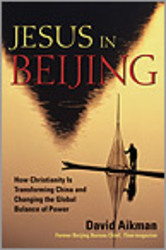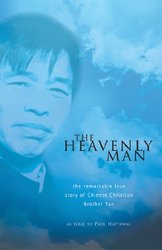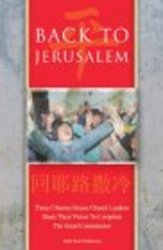Jesus in Beijing: How Christianity is Transforming China and Changing the Global Balance of Power by David Aikman. Regnery Publishing, Washington, DC, 2003. ISBN 0-89526-128-6.
The Heavenly Man: The Remarkable True Story of Chinese Christian Brother Yun by Paul Hattaway. Monarch Books, UK & USA, 2003 edition. ISBN 1-85424-597-X; ISBN 0-8254-6207-X.
Back To Jerusalem: Three Chinese House Church Leaders Share Their Vision to Complete The Great Commission by Brother Yun, Peter Xu Yongze and Enoch Wang with Paul Hattaway. Piquant, Authentic Media, USA, 2003 edition. ISBN 1-884543-89-8
Reviewed by Samuel E. Chiang
Jesus in Beijing
At the turn of this century, China captured the imaginations of many with the lure of billions to be served and equally tantalizing billions to be made in trade. Consider this: China alone accounted for forty-one percent of the growth of the total world oil demand in the last twelve months;[1] forty percent of the world’s cement; thirty-one percent of global coal; thirty percent of iron ore; twenty-seven percent of steel products; and twenty-five percent of aluminum.[2]
Borrowing a geopolitical practice from the United States of securing one’s own backyard (Central and South America), China has commenced the shaping of her own backyard through the process of a “Free Trade Area” with the ten Associations of Southeast Asian Countries.[3] By 2010, this will create the world’s largest tariff free trade zone for nearly two billion people with a combined gross domestic product of more than two trillion US dollars.
David Aikman’s peering into China in light of its regional and global contexts is significant. Library stacks are generally full of books on military, political and economic prowess of nation-states. Seldom is there a contribution of knowledge from the social and societal fabric viewpoint and much less from a Christian perspective supported by a cast of Christian characters. This is why Jesus in Beijing is remarkable, significant and destined to be a “timeless” book as required reading for many in years to come.
Stringent in words, yet finely detailed, Aikman starts with the historical journeys of the Nestorians, Franciscans, Jesuits and Protestants of the nineteenth century. Interestingly, “tentmaking” and illegal “smuggling” for ministries in China have had precedents in the modern mission movement since the 1800s. His short section on “Opium Boats and Christian Tracts” may lead readers to a deeper reflection that perhaps God had a purpose in closing China to the outside world in the middle of the last century.
With the roots of Christianity introduced, China’s door closed and then reopened to the outside world, Aikman aptly moves on to establish the “Patriarchs” of the modern Christian faith in Chinaa faith that is virtually indigenous.
Being politically correct, Aikman does not discuss three decades worth of missing pastors and Christian leaders due to China’s attempt to wipe out Christianity. He focuses, rather, on those whom God has preserved: Wang Ming Dao, Allen Yuan, Samuel Lamb, Moses Xie and Li Tianen. Biographical descriptions and contextual nuances will allow any student of Christian history to appreciate the presentation from a first person account. Furthermore, Aikman has probably whetted many people’s appetites for an account of Christian history from 19491979. Each patriarch presented also represents many others who have stood for the “faith”; fewer and fewer are going to march forward into this century. There is a potential wealth of church history of that era that will be lost forever.
The chapters on “Aunts and Uncles,” and “Nieces and Nephews” wonderfully present the body of Christ in China. While not talking about the fullness of the body (many other church networks), there is a sense of the body dynamics. There are three areas of interest here: Aikman explores the house church “networks” and the possible numbers of Christians in China; he examines their theology and an indigenized “Confession of Faith”; and he introduces a further cast of multigenerational leaders who are making an impact in China. While I sincerely do not believe the “Confession of Faith” is indigenous in nature (I suspect much foreign assistance was provided to come to this understanding), I do believe that it is significant that the house church groups came together on agreement of the precious faith. (It is difficult to secure agreements amongst Chinese church leaders on many things).
Four short pages are devoted to Lu Xiaomin, or “Sister Ruth,” who has been enabled by the Holy Spirit to write many songs which have become known as “Songs of Caanan.” I suspect there will be future volumes on Sister Ruth and many stories throughout China on how her indigenous songs are used by God.
In his survey of Christianity in China, Aikman skillfully weaves in seminary training, the ministries of foreigners in China (and their code words), the State church, the Catholic church, some of the Mainland Chinese Christians overseas and the relationship of official bodies in the international realm.
Interestingly, this book has stirred up controversy in different circles. For example, The Wall Street Journal actually reviewed the book and took Aikman, the former Beijing bureau chief for Time magazine, to task for providing only anecdotal evidence for a book with such a title and importance. In other circles and with people who have participated in China ministry, suggestions came forth that Aikman was “paid” for the book to reveal and to take down the “Church in China.” I have found both accusations silly. In fact, when a China-based correspondent of The Wall Street Journal requested a meeting,[4] I took the opportunity to let him know that the passion of Aikman is clear, and the implications for Christian transformation and global power are significant.
One of the revealing themes that is somewhat teased out in the book has to do with the “Back to Jerusalem” movement and the potential actualization of this goal. At the heart of the question is, “Would China be able to send 100,000 evangelists across the Silk Road to bring the gospel back to Jerusalem?” Aikman uses broad strokes in this matter and leaves it in a curious state.
The Heavenly Man and Back to Jerusalem
Meanwhile, Paul Hattaway has written two books. One is The Heavenly Man, written with Brother Yun (who is known as the “heavenly man”), and the other is Back to Jerusalem. Both books have raised the imaginations and ire of many!
The Heavenly Man is a quasi autobiographical account of Liu Zhenying, known as Brother Yun and also known as the “heavenly man.” (If you are curious about this title, you may wish to read the book to understand how it came to be). In the broadest sense, this book is one man’s perspective on how the church in China has developed. (Aikman provides a much better, deeper and broader perspective of the development of the church.) From a purely spiritual-devotional literature viewpoint, this is a viable book since no one can, nor should, argue with someone’s experience in Christ.
Brother Yun is the “authorized representative” to speak for the house churches around the world; in fact, a grouping of house churches of 58 million adherents, called the Sinim Fellowship had drafted such a letter.[5] Sadly, the Sinim Fellowship was only mentioned once in Aikman’s book, and the authorized representative who is to speak for China, who is recognized by the “uncles,” was missed in Aikman’s book, as well as any mention of Paul Hattaway’s two books. Shoddy journalism? Perhaps. Or did Aikman’s journalistic instincts tell him more, informing him to stay away from the real, first-class controversies? I suspect the latter!
Some former reviewers of both of Hattaway’s books have become resoundingly concerned with the books.[6] The Sinim Fellowship no longer exists and depending on whom one believes, the Sinim Fellowship might have disbanded even prior to the publication of both of Hattaway’s books. Moreover, for argument’s sake, let us suppose the Sinim Fellowship (if it ever did have a large a number of believers) did disband after the publication of the books. One would have thought that this fact would have been revealed in later reprints of the books—especially since there are three different versions of The Heavenly Man in the market place.
What about “Back to Jerusalem”? Is this a vision, or a legitimate movement, and what will be the future of the Mainland Chinese church in Central Asia and in the Middle East? The origin of the “Back to Jerusalem” vision came to several groups of people in China and is well documented in Aikman’s book. However, in Hattaway’s book, one may come away with the impression that the entire house church movement, especially in the rural areas, is all imbued with the “Back to Jerusalem” vision. I do not believe this is the case as asserted by the book.
The original vision to preach the gospel “Back to Jerusalem” was to involve seven countries including: Afghanistan, Iran, Arabia, Iraq, Palestine, Syria and Turkey. An original group formed and was called the “Back to Jerusalem Evangelistic Band.” However, it was not a movement, and, in fact, all activities stopped in 19491950. Some of the Chinese Christians had gotten as far as Xinjiang.
In Hattaway’s book, Back to Jerusalem, the enlargement of the original vision is real; he provides a list at the back, which includes not only the Islamic world but also the Buddhist and Hindu worlds. There are a total of 51 countries. Is this the new vision or a self-serving vision from the West? Many Christian leaders in China have the desire and passion to take the gospel back to Jerusalem. I heard this passion voiced as early as 1991; however, if you were to ask the church leaders which countries are involved in this vision, not many can name 51 countriesand even the original seven may be a stretch!
Chinese publications, such as the Great Commission Bi-Monthly Journal take the traditional meaning of the Silk Road as going through Central Asia and on into the Middle East.[7] This concurs with Aikman’s research and understanding of the “Back to Jerusalem” intentions. However, in Back to Jerusalem, Hattaway, along with his cohorts, insists on two additional silk routes which conveniently include the Hindu and Buddhist worlds. This enlargement of the vision will require people. Are there 100,000 Chinese cross-cultural missionaries prepared and ready to legally go into these difficult parts of the world?
Currently, the rural house church movement in China is facing tremendous challenges. Regionalization and globalization mean that the lure of money is located in the cities, and many of the younger house church leaders are migrating there. The rural house church is, once again, graying swiftly. These migrating house church leaders are discovering the challenges of the cities: educational differences, legal means of working and accountability. These new social-educational-legal realities are not small.
If the rural house churches are graying swiftly, and if the younger leaders are in a mode of urban migration, then what about the “Back to Jerusalem” movement which is, in fact, tied to the rural house churches? What about the 100,000 cross-cultural missionaries who are under training and ready to go? In fact, I ask the same question: “Where are they? How many are under training and may be able “to go” legally?”
Not a small amount of controversy exists with the “Back to Jerusalem” movement both in and outside of China with respect to human and financial resources. In fact, a formidable group of “Patriarchs,” the same ones introduced in Aikman’s book, are standing up against this movement with Samuel Lamb being the most vocal.
I believe the “Back to Jerusalem” vision is alive and is still in the hearts of many church leaders in China (comprised of people in house churches, official churches and Christians in the market place). This is why Aikman’s chapter on “Artists, Writers and Academics” is significant and ties in well with China’s Christian future. Could it be that God is creating several layered strategies to bring the gospel back to Jerusalem?
Aikman has excelled in bringing contemporary Christian history of China into the new century. Jesus in Beijing is a first-rate, timeless book that is a must read for anyone who is interested in what God is doing in China in the twenty-first century.
Samuel Chiang
Rev. Samuel Chiang was born in Taiwan, grew up and worked in Canada, and graduated from Dallas Seminary. He has started several businesses including a foreign joint venture with a local government in China and also served as the Chief Operating Officer of TWR, an international media organization. He has …View Full Bio


